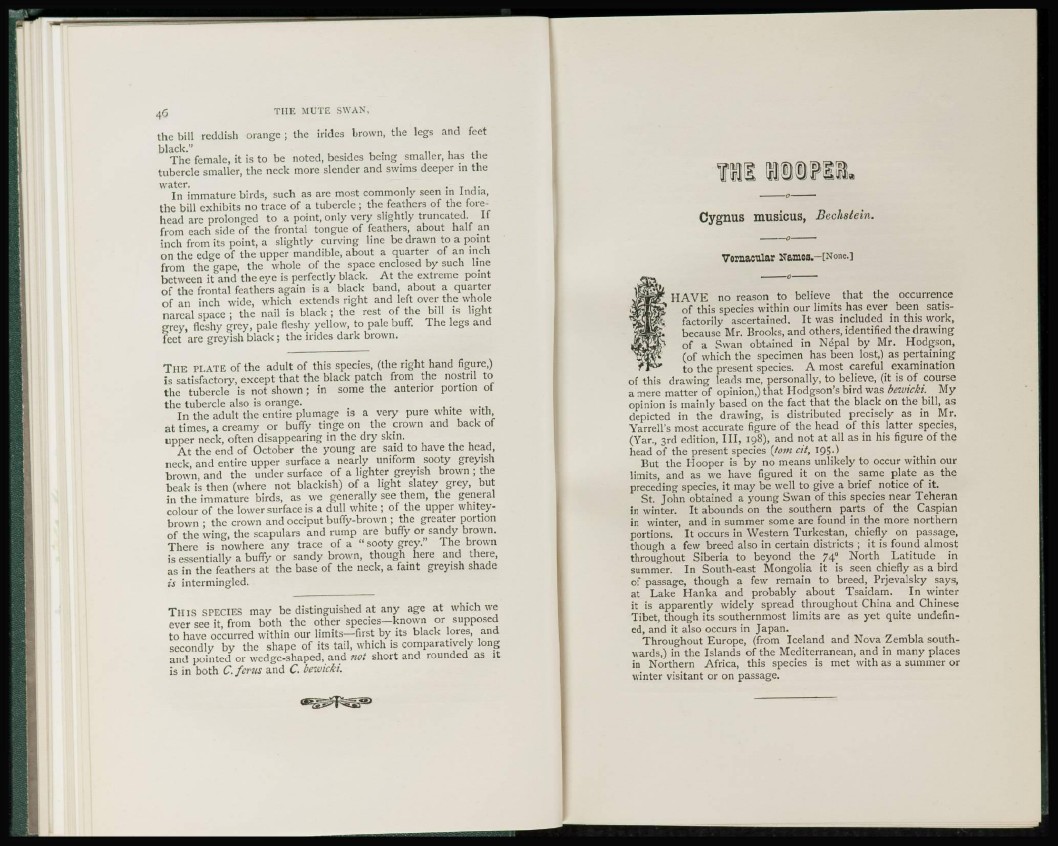
the bill reddish orange ; the irides brown, the legs and feet
black."
The female, it is to be noted, besides being smaller, has the
tubercle smaller, the neck more slender and swims deeper in the
water.
In immature birds, such as are most commonly seen in India,
the bill exhibits no trace of a tubercle ; the feathers of the forehead
are prolonged to a point, only very slightly truncated. If
from each side of the frontal tongue of feathers, about half an
inch from its point, a slightly curving line be drawn to a point
on the edge of the upper mandible, about a quarter of an inch
from the gape, the whole of the space enclosed by such line
between it and the eye is perfectly black. At the extreme point
of the frontal feathers again is a black band, about a quarter
of an inch wide, which extends right and left over the whole
nareal space ; the nail is black ; the rest of the bill is light
grey, fleshy grey, pale fleshy yellow, to pale buff. The legs and
feet are greyish black ; the irides dark brown.
THE PLATE of the adult of this species, (the right hand figure,)
is satisfactory, except that the black patch from the nostril to
the tubercle is not shown ; in some the anterior portion of
the tubercle also is orange.
In the adult the entire plumage is a very pure white with,
at times, a creamy or buffy tinge on the crown and back of
upper neck, often disappearing in the dry skin.
At the end of October the young are said to have the head,
neck, and entire upper surface a nearly uniform sooty greyish
brown, and the under surface of a lighter greyish brown ; the
beak is then (where not blackish) of a light slatey grey, but
in the immature birds, as we generally see them, the general
colour of the lower surface is a dull white ; of the upper whiteybrown
; the crown and occiput buffy-brown ; the greater portion
of the wing, the scapulars and rump are buffy or sandy brown.
There is nowhere any trace of a " sooty grey." The brown
is essentially a buffy or sandy brown, though here and there,
as in the feathers at the base of the neck, a faint greyish shade
is intermingled.
T i n s SPECIES may be distinguished at any age at which we
ever see it, from both the other species—known or supposed
to have occurred within our limits—first by its black lores, and
secondly by the shape of its tail, which is comparatively long
and pointed or wedge-shaped, and not short and rounded as it
is in both C.fcnis and C. bewicki.
CygllUS musicus, Beckstein.
Vernacular Names.—[None.]
HAVE no reason to believe that the occurrence
of this species within our limits has ever been satisfactorily
ascertained. It was included in this work,
because Mr. Brooks, and others, identified the drawing
of a Swan obtained in Nepal by Mr. Hodgson,
(of which the specimen has been lost,) as pertaining
to the present species. A most careful examination
of this drawing leads me, personally, to believe, (it is of course
a mere matter of opinion,) that Hodgson's bird was bewicki. My
opinion is mainly based on the fact that the black on the bill, as
depicted in the drawing, is distributed precisely as in Mr.
Yarrell's most accurate figure of the head of this latter species,
(Yar., 3rd edition, I I I , 198), and not at all as in his figure of the
head of the present species [torn cit, 195.)
But the Hooper is by no means unlikely to occur within our
limits, and as we have figured it on the same plate as the
preceding species, it may be well to give a brief notice of it.
St. John obtained a young Swan of this species near Teheran
in winter. It abounds on the southern parts of the Caspian
in winter, and in summer some are found in the more northern
portions. It occurs in Western Turkestan, chiefly on passage,
though a few breed also in certain districts ; it is found almost
throughout Siberia to beyond the 740 North Latitude in
summer. In South-east Mongolia it is seen chiefly as a bird
of passage, though a few remain to breed, Prjevalsky says,
at Lake Hanka and probably about Tsaidam. In winter
it is apparently widely spread throughout China and Chinese
Tibet, though its southernmost limits are as yet quite undefined,
and it also occurs in Japan.
Throughout Europe, (from Iceland and Nova Zembla southwards,)
in the Islands of the Mediterranean, and in many places
in Northern Africa, this species is met with as a summer or
winter visitant or on passage.